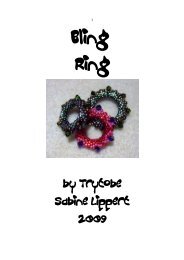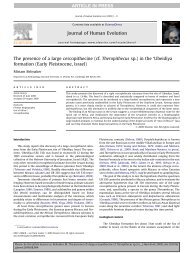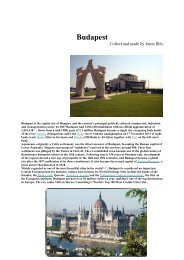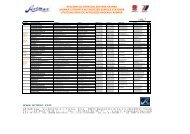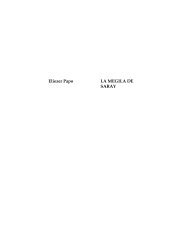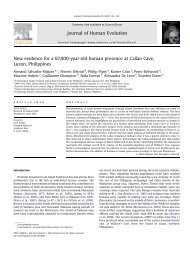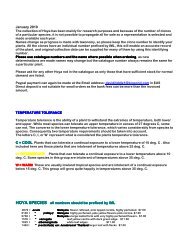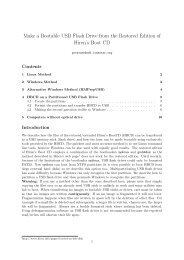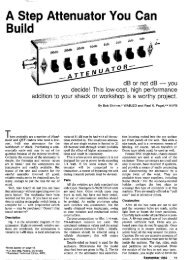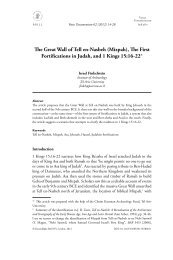Creativity, primordial cognition, and personality
Creativity, primordial cognition, and personality
Creativity, primordial cognition, and personality
Create successful ePaper yourself
Turn your PDF publications into a flip-book with our unique Google optimized e-Paper software.
1780 C. Martindale / Personality <strong>and</strong> Individual Differences 43 (2007) 1777–1785<br />
2. Method<br />
2.1. Participants<br />
Participants were 50 male <strong>and</strong> 50 female undergraduate students enrolled in introductory<br />
psychology classes at the University of Maine. They received partial course credit for participation<br />
in the experiment. Their mean age was 18.7, SD = 1.2.<br />
2.2. Measures<br />
Primordial content was measured using the Regressive Imagery Dictionary (Martindale, 1975,<br />
1990) as applied by COUNT (Martindale, 1973) to machine-readable versions of stories written<br />
by participants in response to the topic: ‘‘A man <strong>and</strong> woman meet <strong>and</strong> go out on a date. Tell what<br />
led up to this, what the characters do, what they are thinking <strong>and</strong> feeling, <strong>and</strong> what happens<br />
afterwards’’.<br />
Martindale (1975) developed a computerized system of content analysis, the Regressive Imagery<br />
Dictionary, which measures the amount of <strong>primordial</strong> content in a text. The dictionary yields<br />
a <strong>primordial</strong> content score, which is the percentage of words in a verbal sample that fall into several<br />
<strong>primordial</strong> content categories. The categories are drives (references to oral, anal, <strong>and</strong> sexual<br />
content), sensations (references to raw sensations, as opposed to abstractions), perceptual disinhibition<br />
(references to disorder in the external world), regressive <strong>cognition</strong> (direct references to<br />
alteration in consciousness), <strong>and</strong> Icarian imagery (references to fire, water, rising, <strong>and</strong> falling –<br />
hypothetically, these are preverbal symbolization of motives <strong>and</strong> emotions). A conceptual content<br />
score – the percentage of words falling into categories tapping temporal references, moral imperatives,<br />
instrumental behavior, social behavior, abstraction, restraint, <strong>and</strong> order is also computed.<br />
The final <strong>primordial</strong> content score is obtained by subtracting the percentage of words falling into<br />
the conceptual content categories from the percentage of words falling into the direct measures of<br />
<strong>primordial</strong> content. These categories were constructed by searching the theoretical literature on<br />
<strong>primordial</strong> <strong>cognition</strong> for attributes of such thought that could be indicated by word usage. The<br />
assumption is that a person’s state of consciousness or type of thought will be reflected in language<br />
content so that the latter can be used to measure the former. The categories <strong>and</strong> examples<br />
of words contained in each category have been presented in Martindale (1975, 1990). The dictionary<br />
as a whole contains 2900 words. Factor analyses consistently yield one factor with the direct<br />
measures of <strong>primordial</strong> content loading highly on one end <strong>and</strong> the indirect measure loading highly<br />
on the other. Very occasionally, a second factor with an eigen value very close to 1.00 emerges, but<br />
examination of scree plots suggest that it be ignored.<br />
A number of studies supports the construct validity of this scoring scheme. Theoretically, more<br />
<strong>primordial</strong> content should be found in the verbal productions of children (Freud, 1900; Werner,<br />
1948), primitive people (Freud, 1913; Werner, 1948), individuals exhibiting symptoms of psychopathology<br />
(Freud, 1900), people under the influence of consciousness-altering drugs, <strong>and</strong> of hypnosis<br />
(Fromm, 1978), <strong>and</strong> people exhibiting a lot of right- as compared with left-hemisphere<br />
cortical activation (Hoppe, 1977; McLaughlin, 1978). The Regressive Imagery Dictionary has<br />
yielded results in conformity with each of these predictions in a series of 12 studies (see Martindale,<br />
1990, for descriptions <strong>and</strong> the original citations). Indirect evidence for construct validity has



